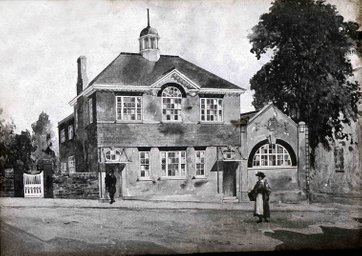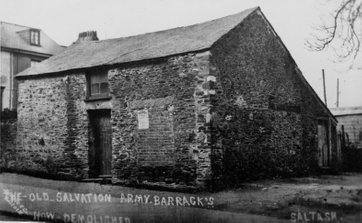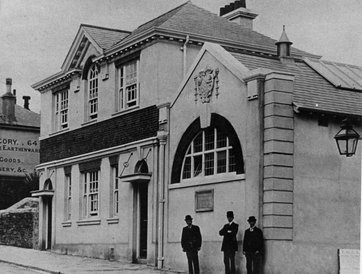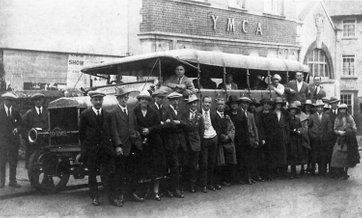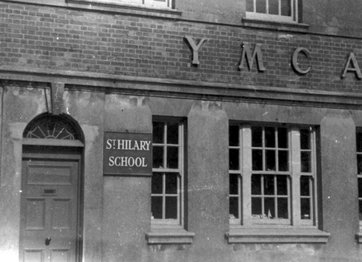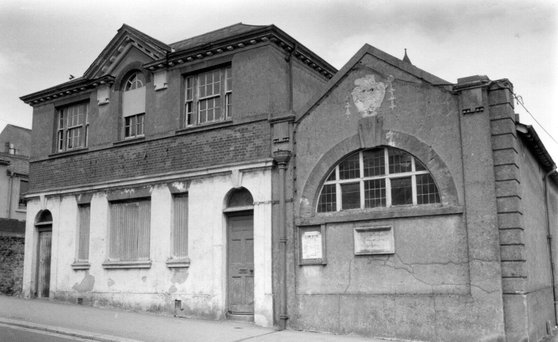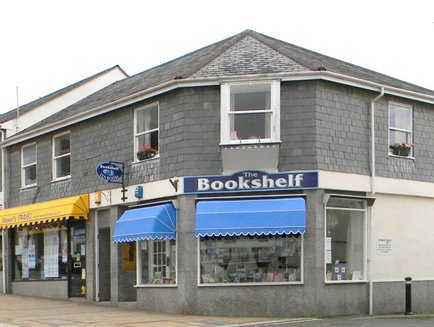Saltash History and Heritage
An era in Saltash history came to an end in January 1976 with the demolition of what was the Young Men's Christian Association (YMCA) building in Fore Street. The stone below the large window of the gymnasium hall of the 'YM' as it was popularly known, read:-
'This stone was laid by E. W. Rashleigh, Esq., J.P. 26th October 1909'
The old barn standing in Archway field which later became the Salvation Army Barracks was demolished to build the YMCA
The YMCA premises were opened on 13th Oct 1910 by Lady Beatrice Pole-Carew of Antony. In this photograph taken in 1910
This was Squire Rashleigh of Stoketon.
The buildings that made up the YMCA were grey-faced, but had an amount of bright brickwork showing to make it ornate. Built on the site now occupied by ‘The Bookshelf and Newells Travel the new building had replaced the old barn standing in Archway Field that had for a time housed the Salvation Army.
Amid great celebrations, including a procession from a gipsy encampment, in the Recreation Ground and led by the Boys' Band from the Mount Edgcumbe Industrial Training Ship, the premises were opened on 13th October, 1910 by Lady Beatrice Pole-Carew of Antony.
Besides the gymnasium run by a Mr. Riddolls, and later by Mr. R. Henwood, the boating club was very popular as was the mid-week football club and their matches that took place on Saturdays. The first secretary was T. W. Downe and then Mr. Sitters, who later moved to the Plymouth YMCA. Mr. R. J. Lucas was in charge of the religious side for many years, the services playing an important role and were supported by various local churches many of which had public figures on the committee.
From the very beginning there must have been some idea of letting part of the premises because in about 1913 a private kindergarten school was started in the two rooms upstairs. Over the years the age group catered for varied as did the name of the school the last being St. Hilary School which used part of the ground floor until December 1958.
When the First World War started in 1914 Soldiers arrived in Saltash and were accommodated in a tented encampment between Cross Park and Wearde, The YMCA headquarters sent a marquee to be erection at the camp. Then as more men arrived the rooms of the 'YM' were adapted for their recreation as were premises at the
St. Nicholas and Baptist Churches; the Wesleyan school room was already playing its part. By 1915 a YMCA report in The Saltash Gazette tells us
" ... troops stationed here were making good use of the facilities offered them by the Association. Each night the premises are taxed to the utmost and many enjoyable evenings are spent there".
Following the First War things got back to normal and for the sporting types there was the gymnasium, football, cricket, billiards and table tennis etc. In the 1919/20 season the teams won the Cornwall Football Cup as well as trophies for billiards and table tennis in the Plymouth and District Leagues.
In 1926 a meeting held at the 'YM' decided to form a branch of "The Cornwall County Free Library Scheme" at which Mr. F. R. Pascoe (then secretary for Cornwall Education) spoke. A local committee was formed of Rev. Nelson (Baptist), Canning Vosper, R. J. Lucas and Mrs. Herbert Simons, together with four from the Borough Council, Alderman John Lander and Councillors A. W. Olver, G. H. Howard and J. H. Pooley. The latter was elected chairman and Mr. Lucas the Hon. Librarian. One hundred books were asked for and the library opened on Tuesday and Saturday evenings. By then different parts of the YMCA building were being used by many local organisation but the library with very little local support was given notice to quit on 30th October, 1930. Sunday religious meetings were going well in 1933, while an advertisement in The Saltash Gazette towards the end of the year read:
"Why not hire the Y.M.C.A. Hall for your party this Christmas? Re-decorated. Charges reduced".
A photograph taken in 1925 by W.O. Freeman of a charabanc ready to depart for an outing from the YWCA
The YMCA after closure awaiting demolition
In 1934 the football club for many years a mainstay of the YWCA closed leaving the winter programme with only the men's meetings, billiards and table tennis. In the summer cricket was added to the agenda and continued to be very popular; but financial problems had begun to show.
Francis Dingle became the new secretary. George Downing, his predecessor, ended his annual report with the words,
"Your biggest task lies not in finance, nor in club, but in striving to bring into this Association the Spirit and Fellowship of Jesus Christ that only comes to those who know Him".
In the November the old billiard table was to be sold, the electricity bill reduced as much as possible, and a weekly whist drive introduced. Toe H took the gym twice a week for a boys' club. How many men, then boys, remember the athletic classes of schoolmaster W. Curnow.
Above the gym window was the YMCA symbol, the red triangle, which stands for mind, body and soul. The Association did not come between young men and the church as some people suggest. Many members did good service in their respective churches and the YMCA
Mr. J. G. L. Lang became the president, with Messrs. G. H. Howard and W. A. Trahair as vice-presidents. However 1935 saw the end of Sunday afternoon services, and money-raising took the form of whist drives, ring tournaments, ‘lightning’ billiards, socials, dances and concerts. When the building had opened there was a debt of £600, and thirty-five years later there was still a mortgage of £550.
Saltash YMCA & St Hilary's School
Mr. J. G. L. Lang became the president, with Messrs. G. H. Howard and W. A. Trahair as vice-presidents. However 1935 saw the end of Sunday afternoon services, and money-raising took the form of whist drives, ring tournaments, ‘lightning’ billiards, socials, dances and concerts. When the building had opened there was a debt of £600, and thirty-five years later there was still a mortgage of £550.
In the November an extraordinary general meeting of the committee was told that unless activities other than billiards were started, the building would have to close as a YWCA, its income did not pay for the caretaker. The Council and the County Schools were approached in an effort to find boys who might be interested, a Mr. Callard was at that time running a junior section of the YMCA, Dr. H. I. Hewitt asked if the building was ever financially sound, but the answer he received was 'No'!
During 1936 the Sunday afternoon meetings were re-started and the weekly whist drives were now bringing in some return. Early the following year Mr. Deable, the caretaker, painted the interior of the building. Though a charitable institution the building did not seem to be rated as such. Much help came from Devonport, and even more when Mr. F. C. Dingle gave up as hon. secretary at the end of 1938. The next year the school rent was raised to £52 per annum, of which £12 was to go towards the rates of the school-room; the other parts used would not be charged.
Plans made during the war scare in 1938 came into being towards the end of 1939. They included opening the premises to the Services, with a canteen, billiards, darts and writing room, etc. A Ladies' Auxiliary was formed, but during the Second World War there was nothing like the number of service-men here compared with the 1914-18 war. After only six weeks the ladies in the buffet and writing room were feeling fed up, and in April 1940 the National Council was asked to undertake responsibility for anything in the area to help service-men.
Towards the end of 1940 the YM closed and the large gold letters were taken down. Much of the building but not the school, was taken over for a time by the military; later when firemen were imported from 'up-country' to help fight the blitz, a number came to Saltash and for a time slept in the old gym. The Free Foresters had given up their meetings there owing to the difficulties of travelling in the black-out. The YMCA was closed until 7th November 1945 when St. Hilary's rent went up and the building was re-decorated inside and out, the large letters found, re-gilded and put up.
Another Mr. Lucas (Stan J.) now became hon. secretary, a connection that was to last with only one break until the end of 1951 when Harold Sleep took over. Cricket was soon to the fore with billiards, table tennis and darts, but the vaulting horse and mat were loaned to Mr. Taylor's Youth Club at Waterside (Saltash Boys' Club) for 5 shillings (25p.) per year. Mr. Taylor was one of the 'imported firemen' who stayed on after the war.
By the end of the forties cricket was still popular and football was back on the list at last, using a pitch at Burraton Recreation Field off the Callington Road. A cycling section and a concert party were added to the activities, but due to remaining wartime controls, it was still not possible to obtain sweets, etc. wholesale for the canteen.
The Sunday Evening Fellowship was changed to afternoons and the Towns, women's Guild were by then using the hall regularly at £2 for four afternoons and one evening each month. Saltash Ladies' Choir also came to the premises. It was not until 1954 that real thanks were extended to Mr. Dingle for all he had done and accomplished; nor must the Tookey twins (R.C. and B.T.) be forgotten for all the work they put in to keep the Association's head above water in Saltash.
St. Hilary's School rent had gone up £50 and it now appeared to have dawned that the rates were high because of the school on the premises. Miss Ivory closed the school of sixty children in 1958 and the rates were halved. Mr. Eric Lewis was now secretary. He had joined the 'YM' as a boy.
Gradually the YMCA began to slide out of the town's picture, except for those interested in weight-lifting (which had been added in 1961) and the ever-important billiards, snooker and table tennis. Mr. Malcolm Down was an active helper in later years and afterwards worked so hard at the Kenwanne Centre.
Part of the premises vacated by the school was used for a time by Messrs. Blight, Broad & Skinnard and later, in 1964, by the Motor Training Centre. The secretary at the closing down of the premises on 31st January, 1976 was Mr. David Head.
It was the end of an Association and a building that had done much good, in spite of an uphill struggle almost from its very start.
The view today to be compared with the first two photographs. This prime corner site in Fore St is now home to The Bookshelf and Tea Room.


